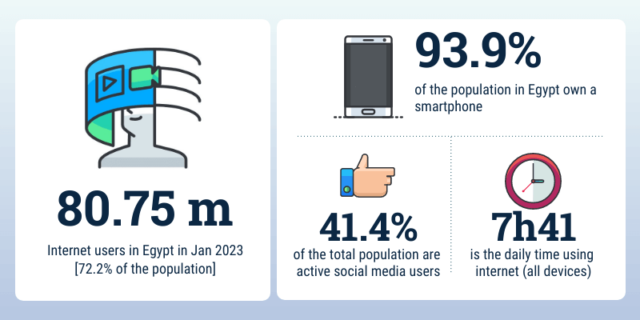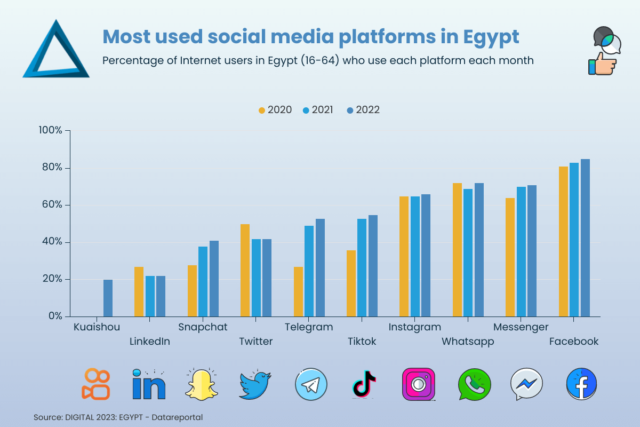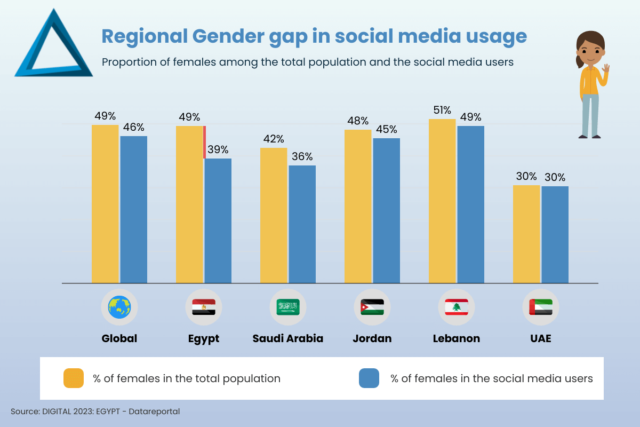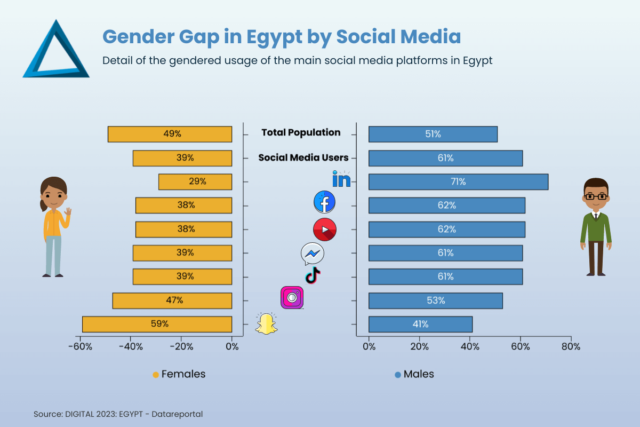We are social, and Metlwater have published the Egyptians and Digital: 2023 Report. It has become a global reference for internet, mobile, and social media stats. Let’s dive into the #Digital2023 report to examine the vital learnings, focusing on Egyptians and the state of digital uses.
=> Consult the latest update here: Egyptians and Digital 2025 Report

INTERNET USAGE IN EGYPT
In January 2023, Egypt’s population touched the mark of 111.8 million, indicating a steady growth of 1.7 million (+1.6%) from the previous year. The country’s digital landscape mirrored this trend perfectly, registering a similar growth rate (+1.6%) in the number of Internet Users. As a result, the digital inclusion quotient, signified by the percentage of Internet Users in the total population, remained consistent at 72%. The penetration rate of mobile devices in Egypt is very high, as almost 94% of the Egyptian population owns a smartphone.
Average online engagement per user in Egypt clocked in at 7 hours and 41 minutes daily, although this was a drop of 41 minutes from the previous year. However, this figure still towers over the global average of 6 hours and 37 minutes. Interestingly, the world, too, observed its first decline in time spent online, contracting by 5% between 2021 and 2022. Despite the global dip and Egypt’s shorter online duration, Egyptians continue demonstrating a robust digital presence, spending significantly more time online than the global average.

EGYPTIANS AND DIGITAL: SOCIAL MEDIA STATISTICS 2022
In January 2023, there were 46.25 million active social media users in Egypt. It is estimated that 60.9 percent of Egyptian aged 18 and above are active social media users.
In 2022, Egyptian internet users aged 16 to 64 spent 2h29 using social media, 3h30 viewing TV programs (broadcast and streaming), and 1h34 using a games console.

Interestingly, almost all media registered a decrease in time spent on media in 2022: -44 min for social media, -35 min for TV, and -28 min for gaming.
Egyptians have likely chosen to resume a “normal social life” in 2022. The year 2021 was still under Covid-19 pandemic restrictions, and people stayed at home and consumed media as ever before.
TOP 10 OF THE MOST USED SOCIAL MEDIA IN EGYPT
Let’s enter the detail on which social media platforms are the most used in Egypt and the significant evolutions between 2021 and 2023:

Egyptians Hold Steady With Well-Established Digital Platforms
Facebook: The social media consistently grew from 81% in 2020 to 85% in 2022. It is the most popular platform throughout these years, with a total number of users in early 2023 of 42 million. 39% of Egyptian internet users in 2023 declared Facebook as their favorite social media platform, confirming its stronghold in the market.
In the report, YouTube is not classified as a social media platform or included in the ranking. Nevertheless, it’s worth mentioning that this video-sharing platform, owned by Google, had 45.9 million users in Egypt at the beginning of 2023, surpassing the number of Facebook users.
WhatsApp and Instagram consistently remain in the third and fourth positions, with stable audiences.
While the percentage usage data showed a decrease in Twitter’s popularity, the potential ad reach increased by 650 thousand (+12.6%) from the start of 2022 to early 2023. But given the significant fluctuations in Twitter’s planning tools, active user trends remain uncertain.
Snapchat holds the seventh position. This platform’s distinctiveness lies in its emphasis on instant and temporary sharing, augmented reality capabilities, and unique focus on personalized and private experiences. Snapchat’s popularity has steadily risen in Egypt, surging from 28% in 2020 to 41% in 2022.
LinkedIn‘s potential ad reach in Egypt increased significantly by 1.5 million (+23.4%) between 2022 and 2023. However, since LinkedIn’s figures are based on total registered members and not monthly active users, it doesn’t directly indicate the trends in active usage. The decline in percentage usage in the original table could be due to inactive accounts or users not utilizing the platform every month.
In summary, while Facebook, WhatsApp, Instagram, and Messenger (all Meta-owned platforms) dominate in terms of usage percentages, platforms like YouTube also hold significant user bases, albeit in different digital domains.
Twitter and LinkedIn, despite showing decreased or stagnant percentages in the original data, show potential for ad reach growth, though their active user trends remain unclear. These insights suggest that marketers need to understand not just overall usage trends but also nuances like user preferences and the potential reach of each platform.
Recent-Comers Confirm And Improve Their Position
The social media landscape in Egypt continues to evolve rapidly. In 2022, another new platform entered the top 10, Kuaishou, a Chinese video-sharing mobile application known for its social network and video special effects editor. Claiming the 10th spot with a 20% usage rate among Egyptian internet users aged 16-64, Kuaishou has overtaken Pinterest by a narrow margin, marking its debut with double-digit growth.
The other last entrants to the top 10 list broke in 2020: TikTok, another video-sharing app, and Telegram, a messaging app.
TikTok had made a significant entry, landing directly in the 7th position. In 2022, the growth trend for TikTok continued, reaching a usage rate of 55% among Egyptian internet users aged 16-64. This confirms a sustained interest in short-form video content among Egyptian internet users.
Telegram is an instant messaging application founded by 2 Russian citizens based in Dubai. It is known for its security, providing end-to-end encrypted communications. Telegram also experienced continued growth. It increased its user base to 53% in 2022. This rise could be attributed to an increasing concern for privacy and security among internet users, making Telegram an attractive choice for many.
In brief, the social media landscape in Egypt shows a clear trend toward platforms that provide short video content and secure communication. It’s an exciting time for the digital sphere in Egypt as it continues to adapt and evolve in response to user interests and global trends.
EGYPTIANS AND DIGITAL: THE SOCIAL MEDIA GENDER GAP
The gender gap in social media usage is the difference between the proportion of men and women using social media and their respective proportions in the overall population. If there’s an equal percentage of men and women in the population, but men make up a larger percentage of social media users, then there’s a gender gap favoring men.
Peeking into the global data, we discover a modest 3.6% gender gap in 2022, with female social media users slightly trailing behind their total population percentage.
Egypt, however, tells another story. January 2023 revealed a robust population of 111.8 million in Egypt, the balance of men and women practically hanging in equilibrium – 50.6% of males and 49.4% of females. This delicate balance, however, stumbles and falls in the world of social media, where men have an undeniable upper hand. In 2022, women made up just 39% of social media users, with men racing at 61%.
The gender gap stretched to 11.2% in 2021, contracting to 10.3% in 2022. While it is a slight improvement, it’s still a considerable chasm compared to the global and regional average.

The MENA region showcases a mixed gender representation. With a 5.4% gap in 2021, Saudi Arabia fell further behind by 0.1% in 2022. Conversely, Jordan emerged as a beacon of improvement, reducing the gap from 4.9% in 2021 to 2.7% in 2022. Lebanon, an outlier with more women than men, also demonstrated progress, slimming the gap from 3.1% in 2021 to 2.2% in 2022.
A curious case is the UAE, a nation brimming with male expatriate workers. Even with a lower female population percentage, women managed to surpass their population percentage on social media in 2021 narrowly. The triumph was fleeting, as 2022 saw a slight reversal with a 0.3% dip.
In conclusion, while the challenge of gender parity in social media usage is a global issue, some countries are making strides toward narrowing the gap. The road is steep for Egypt, where a substantial gender divide that may be linked to female literacy persists.
GENDER GAP BY SOCIAL MEDIA
We also see that gender-differentiated usage is very pronounced when looking at the platform’s detail.

In 2022, the overall Egyptian population split remained roughly equal, with males constituting 51% and females 49%. But we can’t avoid noticing that, proportionally, far fewer women than men use social networks, with distinct gender-differentiated usage of social media platforms.
LinkedIn remains the most male-dominated network, with 71% male and 29% female users in 2022, showing no change in its gender distribution.
By 2022, male usage of Facebool slightly decreased to 62%, and female usage increased to 38%. Despite the slight shift, Facebook remains male-dominated, in almost the same proportions as YouTube, Messenger, and TikTok.
In 2021, Instagram had a relatively balanced gender distribution, with 54% male and 46% female users. By 2022, the platform balanced its gender distribution, with 53% male and 47% female users.
Unlike most other platforms, Snapchat in 2021 had a predominantly female user base of 63%, with males at 37%. In 2022, Snapchat’s female usage decreased slightly to 59%, and male usage increased to 41%, but it remains the platform with the highest female usage rate.
In summary, most social media platforms in Egypt show clear male dominance. Snapchat stands out as the platform with the highest female usage rate. Instagram is the most gender-balanced platform, with a nearly even split between male and female users in 2022.
Find the complete 2023 Report on Egyptians and digital uses here!
CONCLUSION
In Egypt, digital trends and social media usage continuously evolve, revealing an intricate tapestry of trends, behaviors, and potential opportunities. As the #Digital2023 report reflects, the digital world is as dynamic as the physical one, characterized by steady growth, user engagement changes, and shifting social media preferences.
The social media landscape in Egypt, with its distinct mix of global and regional platforms, requires a nuanced understanding and strategic approach. While well-established platforms like Facebook and YouTube maintain their stronghold, newer entrants such as TikTok and Kuaishou rapidly gain ground, reflecting changing user interests and behaviors.
As digital trends evolve, keeping your finger on the pulse of these changes is crucial to remain competitive in today’s digitally connected world. Whether you’re a local business, a multinational corporation, or a non-profit organization, having a robust digital and social media strategy is no longer optional; it’s a necessity. At NAOS Digital, we help you navigate these shifts and strategically manage your digital presence. Our team of digital experts is well-versed in the latest trends and technologies to provide you with effective and efficient social media management.
If you need help understanding these trends and implementing an effective social media strategy, please get in touch with us. Let’s work together to make the most of the digital opportunities Egypt presents today and in the future.
Let NAOS Digital help you connect, engage, and grow in the evolving digital world!

